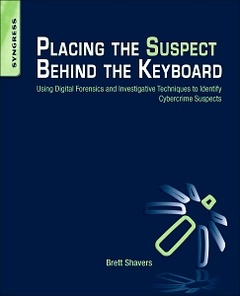Description
Placing the Suspect Behind the Keyboard
Using Digital Forensics and Investigative Techniques to Identify Cybercrime Suspects
Author: Shavers Brett
Language: English
Subjects for Placing the Suspect Behind the Keyboard:
320 p. · 19x23.4 cm · Paperback
Description
/li>Contents
/li>Readership
/li>Biography
/li>Comment
/li>
Placing the Suspect Behind the Keyboard is the definitive book on conducting a complete investigation of a cybercrime using digital forensics techniques as well as physical investigative procedures. This book merges a digital analysis examiner's work with the work of a case investigator in order to build a solid case to identify and prosecute cybercriminals.
Brett Shavers links traditional investigative techniques with high tech crime analysis in a manner that not only determines elements of crimes, but also places the suspect at the keyboard. This book is a first in combining investigative strategies of digital forensics analysis processes alongside physical investigative techniques in which the reader will gain a holistic approach to their current and future cybercrime investigations.
Chapter 1. Introduction
Chapter 2. High Tech Interview
Chapter 3. Physical Investigations
Chapter 4. Technical Investigations
Chapter 5. Putting it all Together
Chapter 6. Investigative Case Management
Chapter 7. Case Presentation
Chapter 8. Cheat Sheets and Quickstart Guides
Chapter 9. Some Things will Become Easier, Others Not So Much
Chapter 10. Online Investigations
Chapter 11. Case Studies
Information Security professionals of all levels, digital forensic examiners and investigators, IT managers, InfoSec consultants, criminologists, sociologists, attorneys, law enforcement officers, Also can sell to forensic training vendors, government training courses, and high-tech crime associations.
- Learn the tools and investigative principles of both physical and digital cybercrime investigations—and how they fit together to build a solid and complete case
- Master the techniques of conducting a holistic investigation that combines both digital and physical evidence to track down the "suspect behind the keyboard"
- The only book to combine physical and digital investigative techniques




